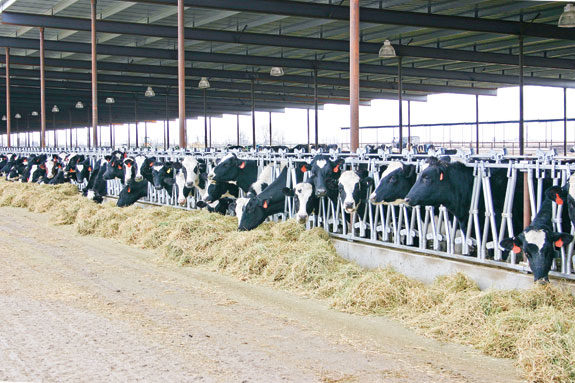Improving feed efficiency seems to be on everyone’s mind nowadays due to high feed costs and fluctuating milk prices. With improved feed efficiency, feed intake can be lower or more milk can be produced on the same amount of feed. This could potentially result in higher profit for the dairy producer.
However, decreasing feed costs through improved feed conversion is not the only way feed costs have been reduced. Diet composition is often adjusted to help decrease feed costs.
Diet components not deemed “necessary” or that are deemed too costly are removed or replaced with cheaper components. Supplements, typically, are the first to go. However, not all supplements should be removed and some are vital to the nutritional status of the cow.
One such supplement is trace minerals. As the name indicates, trace minerals are supplemented in small amounts, often as parts per million (mg of mineral per kg of diet). Due to the small amounts required by the cow (and the cost associated with adding the minerals to the diet), they are often not deemed necessary.
However, this is far from the truth. Trace minerals have three basic functions: structural components of body organs and tissues; components of body fluids and tissues as electrolytes involved with acid-base balance, membrane permeability, and tissue irritability; and catalysts in enzyme and hormone systems.
This makes trace minerals vital for the maintenance, production and health of the cow.
Although trace minerals are naturally present in many feedstuffs, feedstuffs often do not contain the required amounts of each trace mineral. This could be a result of inadequate amounts of minerals in the soil.
For example, in many areas in the West or Northeast of the U.S., soils are considered to have inadequate levels of selenium. Feedstuffs grown in these areas will be deficient in selenium as well. If cows are fed feedstuffs grown in these areas, selenium will need to be supplemented to make up for this deficiency.
Zinc, copper and selenium
This review will focus on three trace minerals (zinc, copper and selenium) and their effects on the immune system. Within the immune system, these minerals play a key role as antioxidants. The role of antioxidants is to help eliminate or lessen the negative effects of oxidants in the body.
Oxidants, also known as free radicals or reactive oxygen species (ROS), are produced during a normal immune response, such as during the destruction of bacteria or an infected cell within the body. These oxidants are unstable and will try to stabilize themselves by “stealing” from other cells in the body.
The oxidants will attack many different types of cells within the body by taking components from their cell membranes. This, in turn, makes the attacked cell unstable and can lead to production of more oxidants.
Cells involved in the immune system are not immune from attacks by oxidants. These cells contain a high amount of polyunsaturated fatty acids in their cell membranes and are very susceptible to “peroxidation” (when oxidants “steal” from lipids in cell membranes).
Furthermore, they produce large amounts of oxidants when attacked.
Antioxidants help prevent this from happening. Antioxidants help to stabilize oxidants. Copper, zinc and selenium are all components of antioxidants. Copper and zinc are a component of superoxide dismutase and selenium of glutathione peroxidase (plus up to 35 antioxidants in total).
These antioxidants help convert harmful oxidants to water within the body. A deficiency of these minerals in the diet and in the animal can result in a decrease in antioxidants and a decrease in protection for immune cells and other vital cells in the body.
Immunity and health
In a review article, researchers stated that a deficiency of selenium, copper and zinc can lead to a decrease in immune function. The review stated that deficiencies resulted in a decreased ability of immune cells to destroy pathogens, which could lead to an increased susceptibility to disease.
These trace minerals, in particular selenium, have been linked to mammary gland health. Studies have shown that selenium supplementation, and high levels of selenium in the blood, have resulted in reduction of new cases of mastitis, lower somatic cell counts and reduction in duration of mastitis.
Similar results have been seen with supplementation of copper and zinc. Supplementation of zinc and copper, along with manganese and cobalt, have also been shown to have a positive effect on claw lesions (reduction in the amount and severity), which will result in a decrease in lameness of the cow.
Production
Milk production has been shown to be positively influenced by supplementation of trace minerals, although this influence does not seem to have a direct effect on production. The effect of trace minerals on milk production seems to be related to health of the udder and health of the animal.
In a review article, an increase in milk production was typically reported along with a decrease in somatic cell counts or improved mammary health when copper, zinc or selenium were supplemented in dairy cows. This increase in milk is likely due to the role these minerals play in the immune and antioxidant systems.
When these minerals are sufficient within the body, there will be adequate amounts of immune cells within the udder to help fight off infection. Also, antioxidants will be present to help decrease the amount of oxidants produced during an infection, which could wreak havoc in the udder.
With a healthy animal and a healthy udder, the cow will have more energy and nutrients available for milk production, instead of trying to fight off an infection.
Summary
Trace mineral supplementation is important for dairy cow production. Trace minerals play key roles in an immune response and udder and cow health.
Maintaining a healthy cow and healthy udder can, in turn, have a positive effect on milk production, and therefore, profitability for the producer. PD
References omitted due to space but are available upon request to editor@progressivedairy.com .
—Excerpts from Diamond V Nutrition Line e-newsletter
PHOTO: In many areas in the West or Northeast of the U.S., soils are considered to have inadequate levels of selenium. Feedstuffs grown in these areas will be deficient in selenium as well. If cows are fed feedstuffs grown in these areas, selenium will need to be supplemented to make up for this deficiency. Photo by PD staff.

-
Kristy Dorton Ph.D.
- Technical Support Manager
- Diamond V
- Email Kristy Dorton Ph.D.











